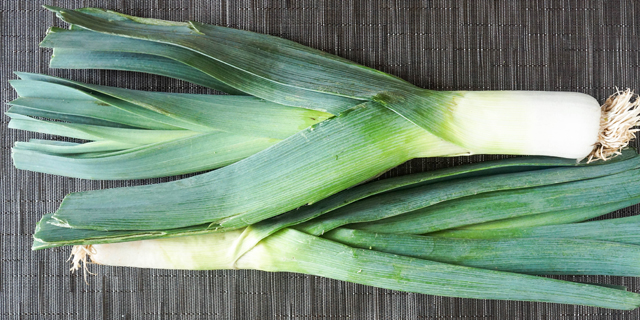For over 3,000 years leeks have been revered for their delicate onion flavor. Commonly used in soups and stews, this incredible vegetable was once referred to as “the poor man’s asparagus.” Luckily, the leek has received a resurgence in popularity in the kitchen and has been used in new, innovative ways not only because of its sweet taste, but ease of use. Leeks are also packed with vitamins and minerals including vitamin K, vitamin A, vitamin C, manganese and folate. The unique nutritional composition of leeks offers incredible cardiovascular support, and they are sinfully delicious when thin sliced and sautéed.
How do I pick the best leeks?
Look for medium leeks, with a stem about 1 1/2 inches in diameter, roots still attached. Roots should look moist and plump, the leek should appear crisp with a long white stem and bright green leaves. Steer clear from leeks that have shriveled, split, or cracked leaves and stems that have gone dull or yellow. The stem should be firm and plump. The inner leaves should have a lighter, brighter color than the outer leaves. Don’t worry if the outer leaves are in bad shape, they will be removed and discarded during preparation.
What can I make with leeks?
One of the most versatile summer vegetables, leeks can be grilled, braised, baked, broiled, boiled, sautéed and enjoyed raw. The sky is the limit on how you want to use them. Start with recipes that could use a milder onion flavor and work your way up to using leeks as your main ingredient. Soups, stews, risotto, tarts, stuffing, frittata, pizza — use them anywhere a sweet, delicate onion flavor is desired.
Preparation involves a quick rinse and chop. Remove the leeks dried outer leaves. Cut leek in half lengthwise, stopping a 1/2 inch from the root end. Place a large bowl under warm running water and dip and swoosh the leeks in the bowl to remove any sand or dirt from the leaves. Rinse until your leeks are clean and grit free. Cut off the dark green tops of the leaves as well as the root end. Then slice, chop and cook them up however you’d like.
Storage? Leeks have a delicate flavor cooked, but in their raw form can be quite pungent. Wrap them loosely in plastic wrap or place in an airtight plastic baggie to keep them from perfuming your fridge. Fresh leeks will keep in the crisper for up to two weeks, while cooked leeks will last up to two days stored in an airtight container. Freezing leeks isn’t recommended since the leeks become bitter and spongy. Luckily, leeks can be found year round so you can enjoy their fresh, delicate flavor whenever the mood strikes!
Recipes to try include: Chorizo Leek Frittata with Spinach, Sancocho, and Vegetable Paella.


![Making Mealtime Matter with La Familia: Easy Sofrito [Video]](https://thelatinkitchen.com/wp-content/uploads/2015/10/sofrito-shutterstock__0-500x383.jpg)
![Easy Latin Smoothies: Goji Berry Smoothie [Video]](https://thelatinkitchen.com/wp-content/uploads/2015/12/goji_berry-shutterstock_-500x383.jpg)
















![Fun and Fast Recipes: Fiesta Cabbage Salad [Video]](https://thelatinkitchen.com/wp-content/uploads/2015/11/fiesta_cabbage_slaw-shutterstock_-500x383.jpg)









